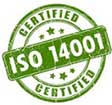Engineering in the design phase is the most critical element of the project.
We will work with you to turn your application into an optimized die casting design, making sure that all your requirements are met. In addition, our die cast engineering team will work with downstream process experts such as quality, machining, and finishing for opportunities to reduce the overall manufacturing costs of the die casting design.
Contact Chicago White Metal for more information on our die cast design services. Contact Chicago White Metal for more information on our die cast design services.
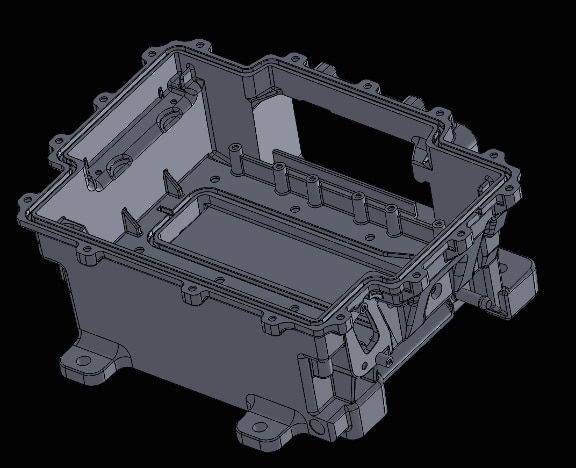
Learn More about Engineering Design Services:
When a design is started from a clean sheet of paper, the designer must disassociate the design constraints from the materials and processes traditionally employed. This 2-page paper reviews the path to the optimum cost-effective results. View the PDF: Developing an Optimum Product Design |
More densely-packed housings, faster processing speeds, and new EMI regulations call for changes in electronic housing designs. This paper frames the EMI shielding challenge, the importance of attention to shielding concerns well before the prototyping stage, and outlines the pros and cons of shielding alternatives in metal and plastic housings. View the PDF: Superior EMI Shielding with Die Cast Housings |
Step-by-step tutorial for a typical electronic enclosure design optimized for die casting takes the product designer through die casting design decisions applying recommended engineering principles appropriate to a range of similar design projects. Published by NADCA. View the PDF: Tutorial: Electronic Enclosure Design for Die Casting |
Step-by-step tutorial for a redesigned bracket design optimized for die casting takes the product designer through die casting design and redesign decisions applying recommended engineering principles appropriate to a range of similar redesign projects. Published by NADCA. View the PDF: Tutorial: Redesigning a Steel Bracket for Die Casting |
Presents the important factors that can affect the outcome of the final appearance of your die cast component when its surface finish is a critical issue. This narrated webinar will aid an understanding of the various finish options, and how their uses and limitations can make the difference between successful product development and costly results. 49 minutes. |
This overview for OEM designers and specifiers is a refresher for those OEM product design engineers, buyers, and purchasing managers already familiar with die casting; and for those new to the process, it provides a valuable framework or further pursuit. View the PDF: The Die Casting Process: An OEM Designer’s Overview |
Presents the facts on why multi-slide, miniature zinc die casting is the preferred choice for small precision components. It enables product designers to learn how this specialized die casting process can substantially reduce component costs and provide optimal precision to a new project design or a conversion from an existing process. |
6-page guide outlines 10 key cost drivers that design engineers can leverage during the product design stage to yield significant cost savings in the custom production of die cast components. These specific planning steps aid in integrating the realities of die cast manufacturing. View the PDF: 10 Ways to Reduce the Costs of Die Cast Parts |
The central component for a newly developed archery bow for serious young archers is a high-tech Al die casting produced to precision tolerance specifications and machined look and feel of a “hog out.” Delivered at the targeted market price, on a tightened time schedule to tie-in with promotional book and film release dates. NADCA Die Casting Award of Excellence winner. (Includes photos) View the PDF: Al Archery Bow NADCA Die Casting Award Winner |
2-page descriptive detailed data sheet for Chicago White Metal Casting’s current high-tech production specifications, material properties, and nominal chemistry for its Al, Mg & Zn alloy capabilities. View the PDF: CWM Al, Mg & Zn Die Cast Production Specs |
16-page, full-color comprehensive brochure on Chicago White Metal Casting capabilities in the most widely specified die casting alloys— Al, Mg & Zn. From design assistance through production, post-casting machining, surface finishing, and final product assembly. Detailed overview covers the experience, advanced technologies, and ISO 9001 & 14001 registered management systems that make CWM the cost-effective choice for net- and near-net-shape die cast parts. Includes case examples. View the PDF: CWM Comprehensive Die Casting Capabilities Brochure |
Updated and expanded 16-page reference to the major design & specification steps that drive the cost and performance of components die cast in Al, Mg, and Zn alloys. Among key design and production factors covered: Matching material properties; Die design & construction; Minimizing part porosity; Optimizing part heat transfer; Preplanning post-casting machining, if required; Dimensioning and tolerancing; Flash considerations; Prototyping; and as-cast finish guidelines. View the PDF: Design & Specification Guide for Custom Die Castings |
An exercise in a step-by-step redesigning a part from a welded steel assembly to a die casting, applying recommended engineering principles, and the 1999 NADCA Product Standards for optimum die casting results. View the PDF: Design of a Bracket for Die Casting Production |
Facts on the material recycling infrastructure long in place for die cast metal parts and recyclability questions designers should ask in selecting materials and manufacturing processes for “green” component design. View the PDF: Designing for Servicing & Recyclability |
An introductory guide to developing the optimum component configuration for cost-effective die cast processing. It provides an overview of design features that enable the designer to capitalize on the inherent advantages of net-shape die cast production. View the PDF: Designing Optimum Part Shapes |
Certain design and production myths regarding die casting may be crippling material and manufacturing decision making. This discussion, by CWM’s V.P. of Engineering, takes a look at today’s die casting design realities. View the PDF: Die Cast Design Myths Can Cripple Optimum Decisions |
Presents data on heat sink materials comparisons and the strengths and weaknesses of heat sinks produced as stampings, extrusions, and die castings. Of special interest to designers less familiar with integral incorporation of heat sinks into a housing design or the potential of custom die cast sink designs View the PDF: Die Cast Heat Sink Can Be a Cost-Effective OEM Choice |
Computer workstations from Silicon Graphics incorporated a zinc die cast rear cap frame, which combined important structural function with superior cosmetic appearance. The Zn die cast component, selected for its excellent strength, rigidity, EMI shielding characteristics, and part consolidation potential, was the first use by the company of a die casting in one of their workstation computers. View the PDF: Die Cast Zn for Key Computer Structural Component |
Preplanning Guide to aid OEMs considering custom die cast part production and reviewing existing literature. Organizes selected industry and CWM design resources into a 7-step sequence for the planning process. The source of each die casting design and production bulletin, tech brief, guide, checklist, and reference manual is listed, with many available for Web downloading or forwarding by Email. Bulletin contains direct Web links to aid access or requests for all listed documents. View the PDF: Die Casting Design & Production Preplanning Guide |
The first motocross design produced on American soil in 20 years features many rule-breaking design innovations, such as its “sweet,” solid shifting clutch, made with two high-tech Al die castings. The Al hub has 35 gear teeth cast to zero draft. The crankshaft and engine cover are AZ91D hot-chamber mag die castings, providing strength and lightweight. View the PDF: Dirt Bike Al Hub with 35 Gear Teeth Cast to Zero Draft |
Project managers for this satellite positioning system designed an Mg die cast enclosure as advanced as the new technology inside: ultra-rugged; lightweight for field use; waterproof; dustproof, with fail-safe EMI shielding. View the PDF: GPS Satellite Tracker Unit in Rugged, Lightweight Mg |
Designed as part of an advanced digital video processing and control system, Sony engineers specified “perfect parts” for their new professional video camera. CWM high-tech die casting was selected to produce 11 aluminum and hot-chamber magnesium housing components for the new camera. Superior as-cast surfaces were primary specifications. View the PDF: GPS Satellite Tracker Unit in Rugged, Lightweight Mg |
Two intricate Al die castings are the heart of a vaporizer-regulator for propane and natural gas vehicles, winning an industry award for their casting excellence. Meeting important thermal and weight specs, the two castings that make up the unit have channel walls, and the spaces between them, that measure 0.040 in. (1.016 mm) thick. View the PDF: Intricate Al Die Cast Propane Vaporizer-Regulator |
World leader in global positioning systems selected Mg die castings for the key housing components in their new optical surveying instrument. Machined parts were rejected as cost prohibitive; plastic would not provide the required stiffness for highly accurate readings. View the PDF: Key High-Tech Mg Parts for Optical Survey System |
This presentation will aid OEM product designers, engineers, and specifiers with valuable, practical guidelines for assuring sound design-for-manufacturing decisions prior to freezing their designs destined for die casting production. View the PDF: Leveraging DFM Prior to Design Commitment |
For users of machined parts looking for opportunities to reduce part costs while improving existing designs, with lower environmental impacts. Narrated webinar covers die cast conversion benefits and when such conversions are and are not advantageous. Tips on how best to make the transfer to an optimized die cast part. Covers conversion design considerations, alloys, and surface finishes— with case studies. 30 minutes. Watch: Machining to Die Casting: A Guide to Conversion Webinar |
Outlines EMI/RFI shielding requirements for electronic assemblies. Presents relationships between common measures of shielding, advantages of die castings in general, and mag die castings in particular, for electronic enclosure shielding. Prepared by Norsk Hydro Magnesium. View the PDF: Magnesium EMI Shielding Characteristics |
Two Mg 12 x 17 in. precision die cast housing walls for an all-in-one multi-media desktop medical imager provide lightweight, multiple functions, and reduced part counts. Each high-tech hot-chamber mag die casting delivers 25 tight-toleranced features as-cast. View the PDF: Medical Imager Mg Multi-function Housing Walls |
First professional digital camera in a magnesium die cast housing, jointly developed by Kodak and Nikon. Mag, selected over the usual alternative of plastic encasing a stamped metal body or an Al casting, provides ruggedness, lightweight, and the quality feel of metal. View the PDF: Mg Die Cast Professional Digital Camera Case |
Eight precision components form the self-contained display and keypad plus probe connector unit for a new all-digital portable ultrasound system. A total component weight of 1.725 lbs. makes the unit lighter than a molded plastic design, with greater drop strength. Winner of a “Design Award of Excellence” from the International Magnesium Assn. View the PDF: Mg Die Cast Ultrasound Portable Workstation Housing |
New Mg die cast support structure for an advanced rear view automotive mirror is now being produced in a high-pressure hot-chamber mag die casting machine with trimming operations eliminated. Employing “in-die de-gating,” two-stage ejection technology, borrowed from miniature Zn die cast production, savings include eliminating the trim die build. (Includes photos) View the PDF: Mg IMA Process Technology Award for Auto Mirror |
This in-depth White Paper from the North American Die Casting Assn. details of how collaborative engineering between OEM engineers and custom die caster engineering can result in improved production efficiencies and reduced part costs. The case study method is used to discuss cost-saving opportunities for existing parts at the point of tooling replacement or required product design revisions, as well as for clean sheet designs. View the PDF: NADCA Collaborative Engineering White Paper |
Detailed overview of the contents of the 176-page Product Design for Die Casting manual on optimizing designs for die casting. View the PDF: NADCA Design Manual: Intro & Content |
Cross-reference chart for former superseded American Die Casting Institute (ADCI) and superseded North American Die Casting Assn. #401 (NADCA) Product Standards and current NADCA Product Standards. (2015) View the PDF: NADCA-ADCI Standards Cross-Reference Chart |
NADCA updated comparison reviews die cast and plastic parts on material availability and recycling, material properties, design tolerances, and material costs. Examines the fact that plastic materials that offer higher strength than mag alloys have material costs that are at least four times greater than magnesium. View the PDF: NADCA: Comparison of Mag Die Casting & Plastic Parts |
Presentation of “Standard” and “Precision” tolerances as outlined in the latest NADCA Product Standards Manual, plus outline of Coordinate Dimensioning vs the advantages of the GD&T framework for specifying die cast parts. View the PDF: NADCA: Coordinate vs Geometric Dimensioning Intro |
Key factors in specifying the production and surface finishing of die cast parts, based on NADCA Product Standards Manual guidelines. Helps assure clearer communication between OEM purchaser and die caster. (2015) View the PDF: NADCA: Die Cast Production & Finishing Checklists |
A concise outline of the specific facts regarding how die casting manufacturing efficiency contributes to ecological sustainability: All die casting metals can be recycled and reused with no loss in material properties, resulting in the vast majority of die castings made with post-consumer metals which, in addition, require far less energy to reprocess than virgin materials. In the production of non-ferrous metal castings, die casting is the most energy-efficient casting process, with reusable molds and very high production rates resulting in highly-efficient energy usage. The carbon footprint of the die casting industry is among the lowest among producers of net- or near-net shape products and component parts—far less than that of plastic injection moldings. View the PDF: NADCA: For Efficient Manufacturing, Look to Die Casting |
Die castings offer exceptional design freedom while at the same time achieving excellent mechanical properties for a product component. Selected features should be designed to enhance casting quality and avoid unnecessary casting costs. This article offers details on key points to consider in optimizing the cost-performance equation for a die cast part. View the PDF: NADCA: Pointers for Designing Die Castings |
Illustrated condensed overview of the basic contents of the die casting industry’s authoritative “Product Specification Standards for Die Castings” reference manual, as originally established in 1997. View the PDF: NADCA: Product Standards Manual Overview |
Aid to understanding die caster tooling requirements for optimum part production: Updated checklists for both new dies, and existing die casting dies to be transferred, based on NADCA Product Standards Manual guidelines. View the PDF: NADCA: Tooling Checklists for Die Casting Dies |
Ruggedness, impact strength, and light weight were key requirements for this handheld field unit for on-site analysis of voice and data. Specifications were met by this hot-chamber Mg die casting housing, which survives 4-foot drop tests to concrete. View the PDF: Only Mg Met Strength-Weight Specs for Voice/Data Unit |
4-page condensed overview of Chicago White Metal Casting capabilities in Al, Mg, and Zn from front-end assistance, prototyping to part finishing, and assembly. Summarizes CWM’s experience, advanced technologies, and ISO 9001 & 14001 registered management systems. View the PDF: Overview of CWM Die Casting & Production Capabilities |
Handheld fiber optic cable analyzer introduced in a high-tech magnesium die cast housing with elastomer overmolding. Innovative case, claimed to be the first overmolding of a complex die casting, offers improved performance over plastic at a 20% saving. View the PDF: Portable Die Cast Mg Case with Elastomer Overmolding |
Overmolding of a die cast enclosure allows product advantages beyond the soft-touch characteristics of elastomers. Tech Brief outlines design considerations that should be addressed by the design engineer planning a marriage of die casting and elastomer overmolding. View the PDF: Preliminary Guide to Overmolding of Die Cast Parts |
Condensed overview for OEM product designers and engineers on Miniature Zinc & ZA-8 custom die casting for the cost-effective production of small, complex structural components. View the PDF: Primer on Miniature Zinc & ZA-8 Die Casting |
Presentation to aid efficiency, functionality, and cost savings in the design and production of custom die castings. This narrated webinar focuses on helping effectively capitalize on today’s advanced die casting capabilities to improve performance and lower the costs of their custom components. 1 hour. |
A value analysis of alternate production efficiencies for a low-volume CNC machined brass small component for a medical device resulted in a miniature zinc net-shape die cast replacement at a 500% unit cost saving. View the PDF: Replacement for Machined Brass at a 500% Savings |
A wireless remote laser unit to aid pipelaying accuracy and efficiency is claimed to be the most powerful laser device of its kind allowed by law. The new model offers an Al die cast metal housing to meet extreme, rugged field conditions, difficult for plastic housings to survive. View the PDF: Rugged Al Die Cast Laser Housing Outperforms Plastic |
This advanced spotting scope, offering the sharpest, brightest viewing at distances greater than possible with premium binoculars, has impressive housing specifications: lightweight portability, absolute ruggedness, 100% waterproof construction— it is nitrogen filled and guaranteed for life. Its central housing is produced as a hot-chamber magnesium high-precision die casting, weighing just 8.0 oz. (226.8 gm) with thin-wall sections as narrow as 0.039 in. (1.0 mm). View the PDF: Rugged Mg Spotting Scope Die Casting Award |
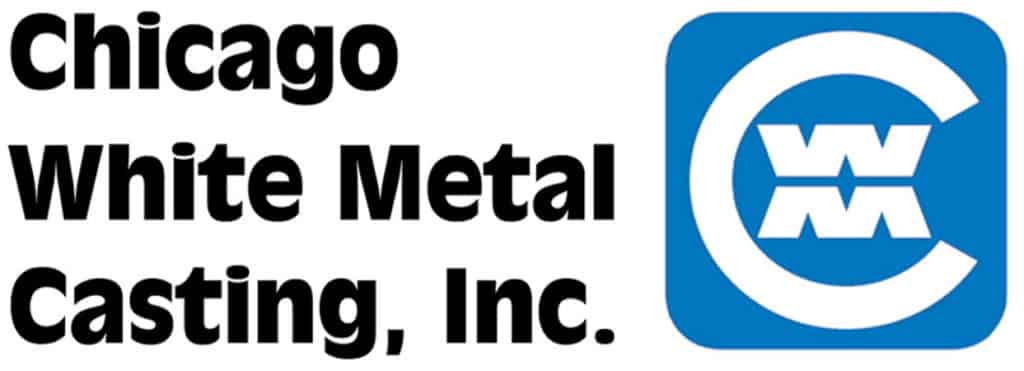
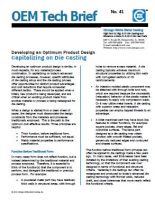 Developing an Optimum Product Design
Developing an Optimum Product Design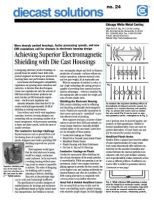 Superior EMI Shielding with Die Cast Housings
Superior EMI Shielding with Die Cast Housings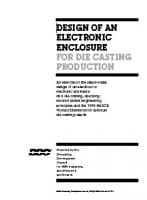 Tutorial: Electronic Enclosure Design for Die Casting
Tutorial: Electronic Enclosure Design for Die Casting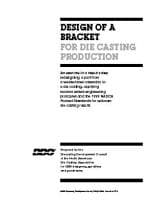 Tutorial: Redesigning a Steel Bracket for Die Casting
Tutorial: Redesigning a Steel Bracket for Die Casting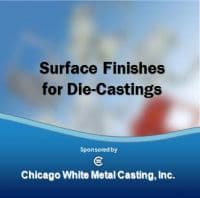 Surface Finishes for Die Casting
Surface Finishes for Die Casting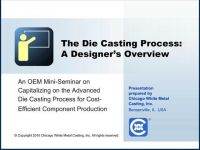 The Die Casting Process: An OEM Designer’s Overview
The Die Casting Process: An OEM Designer’s Overview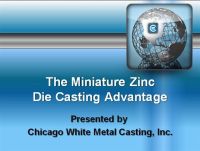 The Miniature Zinc Die Casting Advantage
The Miniature Zinc Die Casting Advantage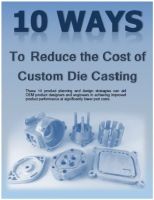 10 Ways to Reduce the Costs of Die Cast Parts
10 Ways to Reduce the Costs of Die Cast Parts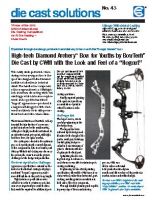 Al Archery Bow NADCA Die Casting Award Winner
Al Archery Bow NADCA Die Casting Award Winner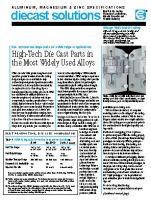 CWM Al, Mg & Zn Die Cast Production Specs
CWM Al, Mg & Zn Die Cast Production Specs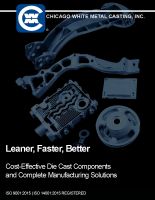 CWM Comprehensive Die Casting Capabilities Brochure
CWM Comprehensive Die Casting Capabilities Brochure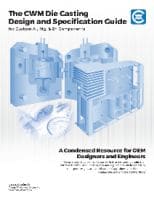 Design & Specification Guide for Custom Die Castings
Design & Specification Guide for Custom Die Castings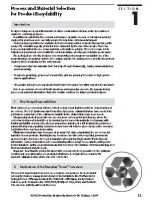 Designing for Servicing & Recyclability
Designing for Servicing & Recyclability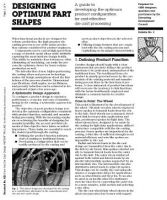 Designing Optimum Part Shapes
Designing Optimum Part Shapes Die Cast Design Myths Can Cripple Optimum Decisions
Die Cast Design Myths Can Cripple Optimum Decisions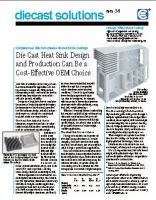 Die Cast Heat Sink Can Be a Cost-Effective OEM Choice
Die Cast Heat Sink Can Be a Cost-Effective OEM Choice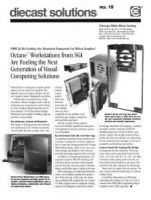 Die Cast Zn for Key Computer Structural Component
Die Cast Zn for Key Computer Structural Component Die Casting Design & Production Preplanning Guide
Die Casting Design & Production Preplanning Guide Dirt Bike Al Hub with 35 Gear Teeth Cast to Zero Draft
Dirt Bike Al Hub with 35 Gear Teeth Cast to Zero Draft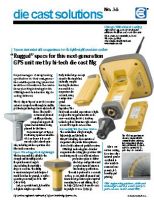 GPS Satellite Tracker Unit in Rugged, Lightweight Mg
GPS Satellite Tracker Unit in Rugged, Lightweight Mg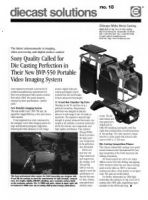 High-Tech Al & Mg for Advanced Video Imaging System
High-Tech Al & Mg for Advanced Video Imaging System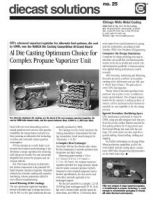 Intricate Al Die Cast Propane Vaporizer-Regulator
Intricate Al Die Cast Propane Vaporizer-Regulator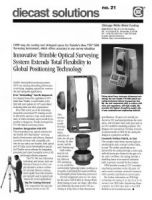 Key High-Tech Mg Parts for Optical Survey System
Key High-Tech Mg Parts for Optical Survey System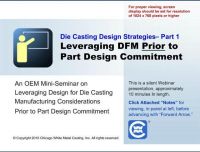 Leveraging DFM Prior to Design Commitment
Leveraging DFM Prior to Design Commitment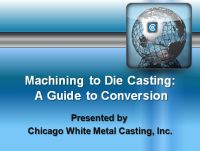 Machining to Die Casting: A Guide to Conversion
Machining to Die Casting: A Guide to Conversion Magnesium EMI Shielding Characteristics
Magnesium EMI Shielding Characteristics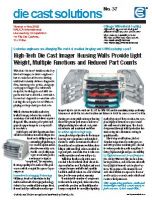 Medical Imager Mg Multi-function Housing Walls
Medical Imager Mg Multi-function Housing Walls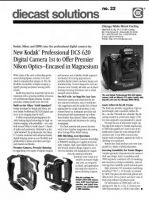 Mg Die Cast Professional Digital Camera Case
Mg Die Cast Professional Digital Camera Case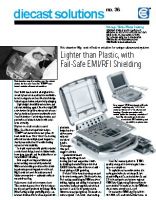 Mg Die Cast Ultrasound Portable Workstation Housing
Mg Die Cast Ultrasound Portable Workstation Housing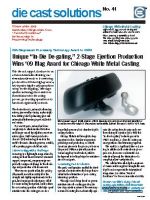 Mg IMA Process Technology Award for Auto Mirror
Mg IMA Process Technology Award for Auto Mirror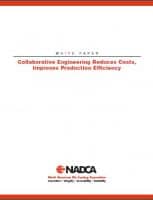 NADCA Collaborative Engineering White Paper
NADCA Collaborative Engineering White Paper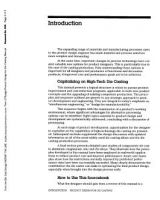 NADCA Design Manual: Intro & Content
NADCA Design Manual: Intro & Content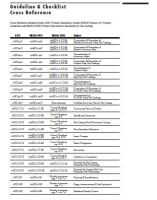 NADCA-ADCI Standards Cross-Reference Chart
NADCA-ADCI Standards Cross-Reference Chart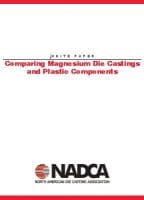 NADCA: Comparison of Mag Die Casting & Plastic Parts
NADCA: Comparison of Mag Die Casting & Plastic Parts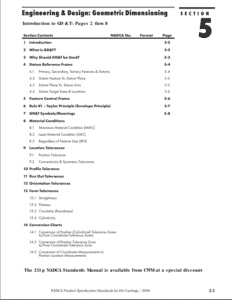 NADCA: Coordinate vs Geometric Dimensioning Intro
NADCA: Coordinate vs Geometric Dimensioning Intro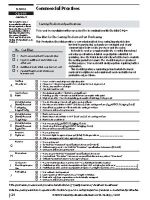 NADCA: Die Cast Production & Finishing Checklists
NADCA: Die Cast Production & Finishing Checklists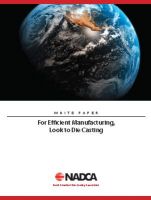 NADCA: For Efficient Manufacturing, Look to Die Casting
NADCA: For Efficient Manufacturing, Look to Die Casting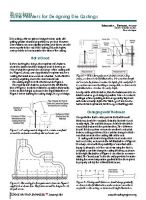 NADCA: Pointers for Designing Die Castings
NADCA: Pointers for Designing Die Castings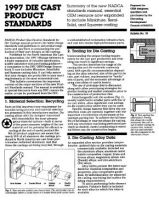 NADCA: Product Standards Manual Overview
NADCA: Product Standards Manual Overview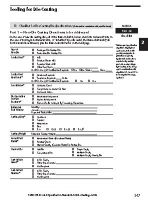 NADCA: Tooling Checklists for Die Casting Dies
NADCA: Tooling Checklists for Die Casting Dies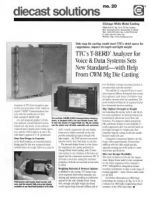 Only Mg Met Strength-Weight Specs for Voice/Data Unit
Only Mg Met Strength-Weight Specs for Voice/Data Unit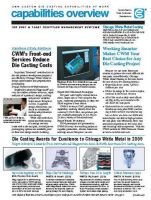 Overview of CWM Die Casting & Production Capabilities
Overview of CWM Die Casting & Production Capabilities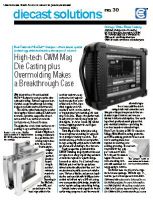 Portable Die Cast Mg Case with Elastomer Overmolding
Portable Die Cast Mg Case with Elastomer Overmolding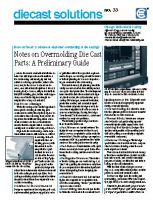 Preliminary Guide to Overmolding of Die Cast Parts
Preliminary Guide to Overmolding of Die Cast Parts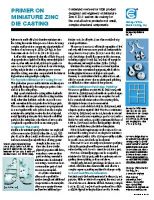 Primer on Miniature Zinc & ZA-8 Die Casting
Primer on Miniature Zinc & ZA-8 Die Casting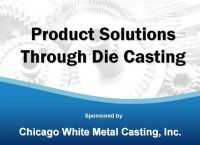 Product Solutions Through Die Casting
Product Solutions Through Die Casting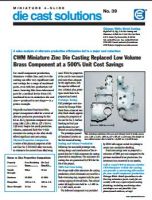 Replacement for Machined Brass at a 500% Savings
Replacement for Machined Brass at a 500% Savings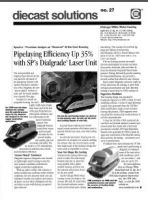 Rugged Al Die Cast Laser Housing Outperforms Plastic
Rugged Al Die Cast Laser Housing Outperforms Plastic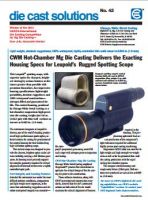 Rugged Mg Spotting Scope Die Casting Award
Rugged Mg Spotting Scope Die Casting Award

